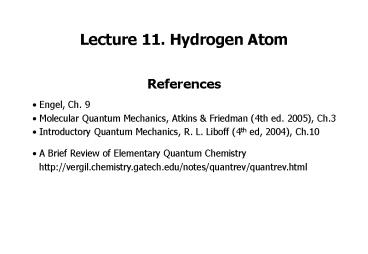Lecture 11. Hydrogen Atom - PowerPoint PPT Presentation
1 / 30
Title:
Lecture 11. Hydrogen Atom
Description:
Lecture 11. Hydrogen Atom References Engel, Ch. 9 Molecular Quantum Mechanics, Atkins & Friedman (4th ed. 2005), Ch.3 Introductory Quantum Mechanics, R. L. Liboff ... – PowerPoint PPT presentation
Number of Views:315
Avg rating:3.0/5.0
Title: Lecture 11. Hydrogen Atom
1
Lecture 11. Hydrogen Atom
References
- Engel, Ch. 9
- Molecular Quantum Mechanics, Atkins Friedman
(4th ed. 2005), Ch.3 - Introductory Quantum Mechanics, R. L. Liboff
(4th ed, 2004), Ch.10 - A Brief Review of Elementary Quantum Chemistry
- http//vergil.chemistry.gatech.edu/notes/quantrev
/quantrev.html
2
(2-Body Problem)
Electron coordinate
Nucleus coordinate
Separation of Internal Motion Born-Oppenheimer
Approximation
Full Schrödinger equation can be separated into
two equations 1. Atom as a whole through the
space 2. Motion of electron around the
nucleus. Electronic structure (1-Body
Problem) Forget about nucleus!
3
in spherical coordinate
4
Angular part (spherical harmonics)
Radial part (Radial equation)
principal quantum no.
, n-1
angular momentum quantum no.
(Laguerre polynom.)
magnetic quantum no.
5
Radial Schrödinger Equation
6
(No Transcript)
7
Wave Functions (Atomic Orbitals) Electronic
States
8
Wave Functions (Atomic Orbitals) Electronic
States
Designated by three quantum numbers
Radial Wave Functions Rnl
9
(No Transcript)
10
Radial Wave Functions Rnl
node
2 nodes
Bohr Radius
Reduced distance
Radial node (? 4, )
11
Radial Wave Functions Rnl
12
Radial Wave Functions (l 0, m 0) s Orbitals
13
(No Transcript)
14
Radial Wave Functions (l ? 0)
15
Probability Density
16
Probability
Wave Function
17
Radial Distribution Function
Probability density. Probability of finding an
electron at a point (r,?,f)
Integral over ? and f
Radial distribution function. Probability of
finding an electron at any radius r
Wave Function
Radial Distribution Function
Bohr radius
18
(No Transcript)
19
(No Transcript)
20
(No Transcript)
21
(No Transcript)
22
p Orbitals (l 1) and d Orbitals (l 2)
p orbital for n 2, 3, 4, ( l 1 ml -1,
0, 1 )
d orbital for n 3, 4, 5, (l 2 ml -2,
-1, 0, 1, 2 )
23
(No Transcript)
24
Energy Levels (Bound States)
25
Ionization Energy
Minimum energy required to remove an electron
from the ground state
Energy of H atom at ground state (n1)
?
Rydberg Constant
Ionization energy of H atom
26
Three Quantum Numbers
- n Principal quantum number (n 1, 2, 3, )
- Determines the energies of the electron
Shells
l Angular momentum quantum number (l 0, 1, 2,
, n?1) Determines the angular momentum of the
electron
Subshells
m magnetic quantum number (m 0, ?1, ?2, , ?l)
Determines z-component of angular momentum of
the electron
27
Shells and Subshells
Shell n 1 (K), 2 (L), 3 (M), 4(N),
Sub-shell (for each n) l 0 (s), 1 (p), 2
(d), 3(f), 4(g), , n?1 m 0, ?1, ?2, ,
?l Number of orbitals in the nth shell n2 (n2
fold degeneracy) Examples Number of subshells
(orbitals) n 1 l 0 ? only 1s (1) ?
1 n 2 l 0, 1 ? 2s (1) , 2p (3) ? 4
n 3 l 0, 1, 2 ? 3s (1), 3p (3), 3d
(5) ? 9
28
Spectroscopic Transitions and Selection Rules
Transition (Change of State)
n1, l1,m1
n2, l2,m2
- All possible transitions are not permissible.
- Photon has intrinsic spin angular momentum s
1 - d orbital (l2) ? s orbital (l0) (X) forbidden
- (Photon cannot carry away enough angular
momentum.)
Selection rule for hydrogen atom
29
Spectra of Hydrogen Atom (or Hydrogen-Like Atoms)
Balmer, Lyman and Paschen Series (J.
Rydberg) n1 1 (Lyman), 2 (Balmer), 3
(Paschen) n2 n11, n12, RH 109667 cm-1
(Rydberg constant)
Electric discharge is passed through gaseous
hydrogen. H2 molecules and H atoms emit lights of
discrete frequencies.
30
(No Transcript)






























